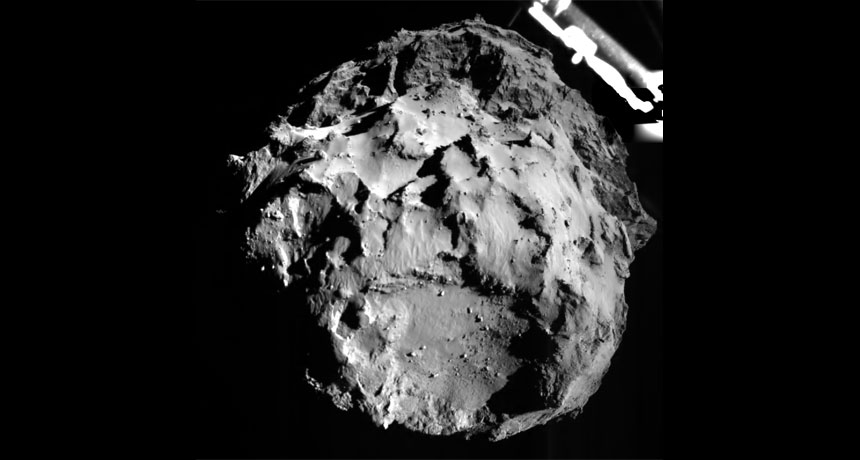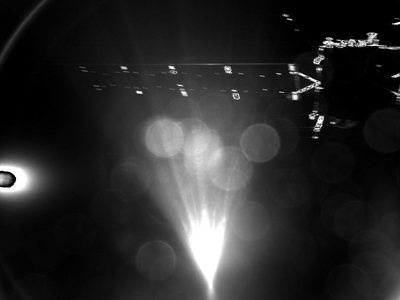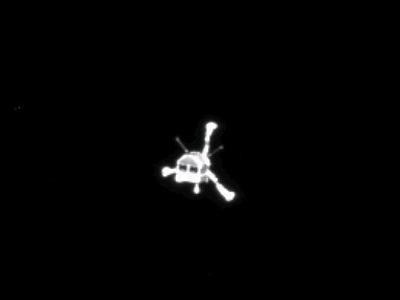Rosetta mission lander set to explore surface of comet
After a few glitches, Philae robotic probe is set to dig into to 67P’s frozen secrets

TOUCHDOWN The comet lander Philae has successfully hit its mark: comet 67P/Churyumov-Gerasimenko. The leg of the lander appears at the right of this image taken three kilometers from the comet’s surface.
ESA/Rosetta/Philae/ROLIS/DLR
DARMSTADT, GERMANY — Philae is now sitting on comet 67P/Churyumov-Gerasimenko. The minifridge-sized lander set itself onto the comet on November 12 and is now preparing to beam back panoramic pictures of its environs and explore the chemistry of the dust beneath its toes.
“We are on the comet,” Philae project manager Stephan Ulamec of the German Aerospace Center in Cologne announced amid cheers and applause as soon as the signal came through at the European Space Agency’s operation center. The successful landing marks the first time scientists have set a spacecraft on the surface of a comet.
The historic landing is more than 20 years in the making and didn’t happen without a lot of hand-wringing. The first glitch arose November 10, when the lander didn’t switch on properly on the first try. Tensions grew even greater on the morning of November 12 when mission scientists identified a problem with the lander’s thruster system. Four attempts to correct the thruster failed, and the team had to clear Philae for launch without a clear sign that the thruster would fire right at touchdown to push the probe downward as its foot screws and harpoons anchored the lander to the comet.

Despite the uncertainty, the team programmed Philae to separate from Rosetta as scheduled. About seven hours after the separation, the signal confirming that the lander had touched down finally came through at 5:03 p.m. Central European Time (11:03 a.m. Eastern Standard Time). There is concern that the harpoons to anchor Philae to the comet did not fire, raising questions about how secure the lander is on the comet. Also, the radio signal from Philae is going in and out, Ulamec said.He speculated that some of the fluctuation may have been due to a slow bounce the lander took just after it set down the first time. In other words, Philae may have landed not once, but twice, he said.
The landing is “simply awesome,” says Jessica Sunshine, a comet expert at the University of Maryland who is not involved with the Rosetta mission. If the cameras work, “we will see what it’s like to be on the surface of a comet, what all that wonderful topography looks like as if we were standing there,” she says. “Philae allows us to experiencelanding on one of the building blocks of the solar system.”
Comets, including 67P, are the left over rubble from the birth of the solar system. Scientists want to study the hunks of ice and dust to understand the sun and the planets’ early history. Rosetta, with Philae on its back, arrived at the solar system relic 67P on August 6 after an epic 10-year journey (SN: 9/6/14, p. 8). It immediately began snapping images of the comet’s surface and studying the space rock’s gravity and other features, mainly to help scientists prepare for Philae’s touchdown. On the day of landing, the comet and orbiter were roughly 500 million kilometers from Earth, somewhere between the orbit of Mars and Jupiter, traveling toward the sun at nearly 66,000 kilometers per hour.

It took months of planning to stick this landing, and when Philae finally got down to 67P, it nestled itself onto the comet’s head, within roughly 100 meters of its intended landing strip, called Agilkia, mission scientists said. They confirmed that the thruster did not fire, validating the malfunction identified earlier. The harpoons to anchor the lander to the comet also failed to fire, Ulamec said. The team is working to figure out why, but it is not likely that Philae operators will try to refire the harpoons. Ulamec did note that based on how the landing gear sunk into the comet’s surface, the team can say that 67P has a soft outer coating.
The team has confirmed that all the instruments aboard Philae are working. The lander’s 10 instruments are designed to complement the 11 aboard Rosetta to study the chemistry and geology of 67P in detail. What the probes discover could give clues to the kind of environment comets were born in and whether the rocky, icy boulders could have brought water and other building blocks of life to Earth (SN: 11/1/14, p. 22).
Of course, comet 67P is one of a trillion in the solar system. “The best data you have from one comet is never going to be perfect science for all of them,” said ESA scientist Mark McCaughrean, who helps advise the mission. There are even issues with how representative Philae’s landing spot is of the entire comet, noted Donald Brownlee, a planetary scientist at the University of Washington in Seattle not involved with in the mission. Comet 67P has a lot of smooth, dusty regions, similar to where the lander was targeted to set itself, that probably differ from the more pristine regions of the comet. “It could be problematic to compare the lander results to freshly exposed material,” he said.
McCaughrean said that one of the best things that happened today is that Philae left Rosetta. “This is terribly disloyal to Philae,” he said, but if the lander had not been working and had to be lugged around, which seemed to be a possibility at one point, it would have been dead weight for Rosetta and could have threatened the orbiter’s scientific success.
Mission scientists did not hesitate to reiterate throughout the day that even if Philae failed, Rosetta is already and will continue to be a success.
Philae, however, sailed to 67P as planned, and along the way started snapping images of its descent. Not a lot of science is slated to come from the early data — that will come later. But, said Matt Taylor, Rosetta’s project scientist at ESA’s Science and Technology Center in Noordwijk, the Netherlands, the key is that finally the science part of the mission is now a go.
Updated, November 13 at 10:48 CET: Mission control is now reporting that Philae actually landed three times yesterday, at 15:33, 17:26 and 17:33 UTC. There are also reports that the probe bounced as high as a kilometer into space between landings.







